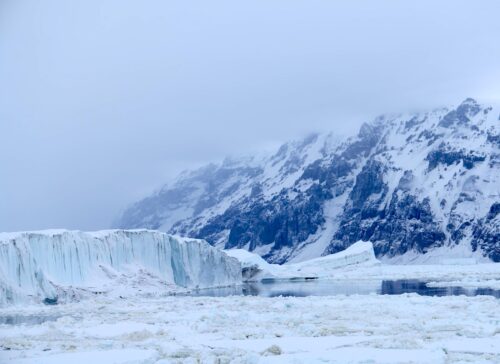
In a recent column titled “A Chart Climate Denialists Can’t Ignore,” Bloomberg writer Mark Gongloff presents a graph from Berkeley Earth’s Zeke Hausfather as proof that “the world is getting hotter, and fast.” [emphasis, links added]
While the chart [shown below] may accurately display data, it is highly misleading because it doesn’t take the root causes of such temperature records into account, such as the urban heat island (UHI) effect and the warm-biased placement of weather stations that record temperatures, factors that have nothing to do with climate change.

The chart, Gongloff claims, shows that nearly 80 percent of global land areas have experienced record monthly high temperatures in this century alone. From this, readers are told that the evidence is overwhelming and that skepticism about catastrophic climate change is “denial.”
It’s a tidy narrative—but like many tidy narratives, it unravels when context and historical data are brought to bear.
The idea that today’s heat is “unprecedented” is simply false. In fact, most all-time state high temperature records in the United States were set long before the 21st century began.
As detailed in Climate at a Glance: The Facts on Climate Change (2nd Edition, 2025), “the all-time high temperature records set in most states occurred in the first half of the twentieth century, decades before anyone was talking about human-caused climate change.”
This is not a small technicality. It is a direct contradiction of the claim that modern warming is without historical parallel.
The 1930s remain the standout decade for heat in the American record. Data, drawn from the National Oceanic and Atmospheric Administration’s (NOAA) U.S. Historical Climatology Network, show that both the number and intensity of heat waves peaked during that period.
The Environmental Protection Agency (EPA) Heat Wave Index, cited in Climate at a Glance, confirms that the 1930s still dominate in frequency and duration of heat waves nationwide. A chart from Our World in Data, shown below, verifies the EPA heatwave data:

More recently, the U.S. Climate Reference Network (USCRN)—a pristine system of modern sensors launched in 2005 to avoid problems like urban heat contamination—shows no sustained increase in high-temperature extremes since its inception, seen in Figure 2 below:

This data matters because the United States has the longest, most carefully maintained temperature record in the world. If there were truly a runaway increase in record heat, it would be evident here first.
Instead, as The Heartland Institute notes, “there has been no significant warming across the United States since 2005” and “recent warming rates are no higher than in the early 20th century.”
The NOAA record confirms this trend: when adjustments and urban heat biases are stripped away, the upward slope of U.S. maximum temperatures largely disappears.
Finally, a chart of high temperature records for the past century, seen below in Figure 3, easily disproves the Bloomberg claim.

What is too often ignored in mainstream reporting is the extent to which temperature datasets have been massaged over the years.
Historical temperatures in the far past are routinely adjusted downward, and station siting biases in the present exacerbate the problem, exaggerating the appearance of a steep warming trend.
An independent audit of the U.S. surface station network done by Heartland in 2022 found that well over 90 percent of stations fail NOAA’s own siting standards, with many positioned near heat sources such as buildings, parking lots, or air-conditioning exhausts.
When only well-sited, rural stations are considered, the long-term warming trend falls dramatically.
This important context is missing entirely from Gongloff’s piece. Instead, readers are presented with an appealing graphic and a few cherry-picked statistics that appear to seal the case.
Yet, as the new Climate at a Glance book points out, climate models and global averages often obscure more than they reveal. “Models run too hot,” the book notes, “and they consistently project more warming than is observed in the real world.”
The gap between modeled projections and measured outcomes has persisted for decades, which raises questions not about “denial,” but about scientific humility.
In the United States, there has been no statistically significant increase in either the number or intensity of heat waves since the early 20th century. That is not a matter of ideology—it is a matter of record.
Gongloff closes his piece by warning that the 1930s Dust Bowl may soon “seem like a cool interlude.” That is preposterous – the data tells a completely different story. America’s hottest decade remains the 1930s, and despite rising carbon dioxide emissions, modern heat extremes have not surpassed those early records.
Before accepting graphics designed to shock, it’s worth remembering that charts can be constructed to emphasize whatever conclusion the author prefers. History, on the other hand, does not bend so easily.
Ultimately, long-term unbiased data and a proper accounting of the UHI effect destroy Bloomberg’s intentionally alarming claims about a rapidly warming world.
Top Image by WikiImages from Pixabay
Read more at Climate Realism



















In the 1930’s it was very hot in the United States. In the 1930’s Europe experienced extreme heat and drought in many areas, especially northern Europe. In the 1930’s parts of Asia experienced excessive warming. In the 1930’s Australia experienced exceptional warming and an exceptional dry climate. In the 1930’s South American and Africa didn’t have excessive warming, but both continents experienced extreme drought. The pushes of the climate crisis narrative try to explain each of these events as isolated from each other. However, the dust bowl in the US, heat and drought in Europe, excessive warming in Asia, heat and drought in Australia, and extreme droughts in South American and Africa all happened in the 1930’s. They were obviously part of a larger global climatic fluctuation before carbon dioxide was considered significant.
The article mentioned the temperature records of the far past being adjusted downward to make it appear there has been more warming. Also, many stations in the cooler locations at higher altitudes and rural areas have been eliminated, which means those remaining will have a higher average. Another item – I don’t know if this is still happening after Trump was elected, but people observing the current data have noticed tampering. A station for a particular day would have a reading, and then that was changed to missing. A few days later the missing status was replaced by a simulated value half a degree warmer than the original. The answer as to why there is so much fraud is obvious. The true temperatures values do not support the climate crisis narrative.
There is also fraud in selling the climate crisis. It is well known that climate mode RCP 8.5 is so extreme there is no chance of it happening. Yet, an exaggerated version of RCP 8.5 was used to make the official US climate assessment. The studies predicting the demise of various crops such as coffee are often based on RCP 8.5.
This article asserts that there has been no warming. That may be true, or we may have experienced moderate warming. Whatever the case, spending trillions to force green energy and other actions such as outlawing new ICE cars are not justified.
As a longtime Heartland supporter, I would like to read Heartland and or Mr. Watts response to Mr. Greene’s comments. None of us want partisan science. We want accurate reporting. I note Mr. Greene does not address UHI effects and official warming adjustments to temperatures and appears to be assuming that official records are accurate. I also note that ultimately he agrees that CO2 caused warming shows no evidence of Armageddon. Let’s not distort things to make an argument as it hurts credibility. His point about models is very important to address as it is about the most common point made by skeptics.
I thought the same thing about seeing a reply by Anthony Watts to Greene’s diatribe. Greene has frequently poo-pooed the whole concept of UHI in previous posting as if it doesn’t exist. And he writes as if he’s an expert and disparaging articles written by esteemed scientists with PhDs in appropriate degrees related to climate as opposed to Greene who has an MBA.
The US is only 1.6% of Earth’s surface.
Not 100%
CO2 mainly effects Tmin, not Tmax.
The average global temperature has significantly increased since 1975.
That fact does not change by saying parts of the US had extreme heat in the 1930s.
The world was not warmer in the 1930s; in fact, the average global temperature was significantly cooler than today, though some regions like North America experienced extreme heat due to factors like the Dust Bowl. The 1930s heat wave was a localized phenomenon, while modern global warming affects the entire planet and has resulted in much higher overall temperatures.
The author is data mining a tiny portion of the world’s surface to fool people … approximately half the contiguous U.S. states set or tied their all-time high temperature records during the 1930s Dust Bowl heat waves. This is less than 1% of Earth’s surface.
The author is ignoring nights.
Nights (Tmin) are warming more rapidly than days (Tmax). Since 1901, the average rate of warming for overnight low temperatures across the contiguous U.S. has been 1.45°F per century, significantly outpacing the 1.13°F per century for daytime high temperatures.
That climate models run too hot is a lie.
The average climate modeled from the 1970s, when programmed with actual CO2 growth, has been surprisingly accurate.
Conservatives hate that fact.
So they program models with unrealistically fast CO2 growth called RCP 8.5. That makes the models predict faster warming, and then they claim the models are wrong.
The goal of many conservatives is to say that CO2 does nothing.
The goal of many liberals is to say that CO2 is dangerous.
They will both lie & data mine to “prove” their conclusions.
In reality, CO2 does some amount of global warming.
The past 50 years of global warming has been pleasant climate change.